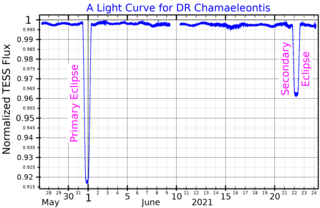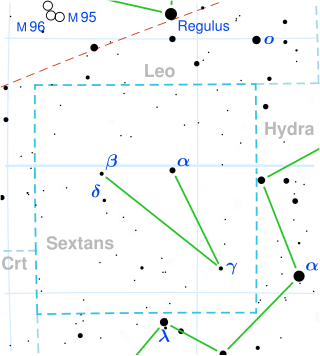
HD 27245, also known as HR 1335 or rarely 25 H. Camelopardalis is a solitary red-hued star located in the northern circumpolar constellation Camelopardalis. It has an apparent magnitude of 5.4, making it faintly visible to the naked eye. Gaia DR3 Parallax measurements place it approximately 607 light years away from it the Solar System and is drifting further away with a heliocentric radial velocity of 25.2 km/s. At its current distance, HD 27245's brightness is diminished by 0.36 magnitudes due to extinction from interstellar dust. It has an absolute magnitude of −0.27.
Z Camelopardalis (Z Cam) is a cataclysmic variable star system in the northern constellation of Camelopardalis. It has an apparent visual magnitude which varies between 9.8 and 14.5. This system is the prototype star for the family of Z Camelopardalis variable stars: dwarf novae with standstills at a brightness intermediate between their maxima and minima. It may be the same bright nova that was recorded by Chinese astrologers in the autumn of 77 BCE.
μ1 Chamaeleontis, Latinized as Mu1 Chamaeleontis, is a single star in the southern circumpolar constellation Chamaeleon. It is dimly visible to the naked eye with an apparent visual magnitude of 5.53. Based upon parallax measurements, it is located approximately 403 light-years away from the Sun. The radial velocity is poorly constrained, but it appears to be drifting further away at the rate of about 16 km/s

S Apodis, also known as HD 133444 is a variable star located in the southern circumpolar constellation Apus. It has an apparent magnitude ranging from 9.6 to 17, which is below the limit for naked eye visibility. The object is located relatively far at a distance of approximately 15,000 light years based on Gaia DR3 parallax measurements, but it is drifting closer with a heliocentric radial velocity of −75 km/s.

HD 90132 is a solitary white hued star located in the southern constellation Antlia. It has an apparent magnitude of 5.33, making it one of the brighter members of this generally faint constellation. The star is relatively close at a distance of 135 light years but is receding with a heliocentric radial velocity of 17 km/s.

HD 138289, also known as HR 5757, is a probable spectroscopic binary located in the constellation Apus, the bird-of-paradise. It has an apparent magnitude of 6.18, placing it near the limit for naked eye. Gaia DR3 parallax measurements place the object 359 light years away and it is currently receding with a heliocentric radial velocity of 13.1 km/s. At its current distance, HD 138289's brightness is diminished by 0.25 magnitudes due to extinction from interstellar dust. It has an absolute magnitude of +1.21.

Zeta Octantis, Latinized from ζ Octantis, is a solitary, yellowish-white hued star located in the southern circumpolar constellation Octans. It has an apparent magnitude of 5.42, making it faintly visible to the naked eye under ideal conditions. The star is located relatively close at a distance of only 156 light-years based on Gaia DR3 parallax measurements, but is drifting closer with a radial velocity of −3.6 km/s. At its current distance, Zeta Octantis' brightness is diminished by 0.25 magnitudes due to interstellar dust.

HD 76236, also designated as HR 3543 or rarely 11 G. Chamaeleontis, is a solitary star located in the southern circumpolar constellation Chamaeleon. It is faintly visible to the naked eye as an orange-hued star with an apparent magnitude of 5.77. Based on parallax measurements from the Gaia satellite, the object is estimated to be 612 light years away. Currently, it is receding with a heliocentric radial velocity of 7 km/s. At its current distance, HD 76236's brightness is diminished by 0.39 magnitudes due to interstellar dust. It has an absolute magnitude of −0.13.

14 Trianguli, also known as HD 15656, is a spectroscopic binary located in the northern constellation Triangulum. It has an apparent magnitude of 5.14, making it faintly visible to the naked eye in ideal conditions. Gaia DR3 parallax measurements place the system 433 light years away, and it is currently approaching the Solar System with a heliocentric radial velocity of −37 km/s. At its current distance, 14 Tri's brightness is diminished by 0.21 magnitude due to interstellar dust. It has an absolute magnitude of −0.46.
HD 75171, also known as HR 3495, is a solitary, white hued star located in the southern constellation of Volans. It has an apparent magnitude of 6.02, making it faintly visible to the naked eye under ideal conditions. The object is relatively close at a distance of 191 light years but is receding with a heliocentric radial velocity of 10.7 km/s. Eggen (1995) lists it as a probable member of the Hyades Supercluster.

AF Columbae, also known as HD 42682, is a solitary, red hued variable star located in the southern constellation Columba, the dove. It has an apparent magnitude that fluctuates between 5.6 and 5.71. Nevertheless, it is faintly visible to the naked eye. Parallax measurements from the Gaia spacecraft place the star relatively far at a distance of 820 light years. However, it is approaching the Solar System with a poorly constrained radial velocity of −19 km/s.

DR Chamaeleontis, also known as HD 93237, is a star located in the southern circumpolar constellation Chamaeleon. The system has an average apparent magnitude of 5.97, allowing it to be faintly visible to the naked eye. DR Cha is located relatively far at a distance of 1,060 light years based on Gaia DR3 parallax measurements, but is receding with a poorly constrained heliocentric radial velocity of 18 km/s.

PW Telescopii, also known as HD 183806 or simply PW Tel, is a solitary variable star located in the southern constellation Telescopium. It has an average apparent magnitude of 5.58, making it faintly visible to the naked eye. Based on parallax measurements from the Gaia satellite, the star is estimated to be 395 light years distant. It appears to be approaching the Solar System with a heliocentric radial velocity of −10 km/s. The value is somewhat constrained, having an uncertainty of 26%. At its current distance, PW Tel's brightness is diminished by 0.05 magnitudes due to interstellar dust.

HD 197630, also known as HR 7933 or rarely 23 G. Microscopii, is a probable astrometric binary located in the southern constellation Microscopium. The visible component is a bluish-white hued star that is faintly visible to the naked eye with an apparent magnitude of 5.47. Based on parallax measurements from the Gaia satellite, the system is estimated to be 328 light years away. However, it is drifting closer with a heliocentric radial velocity of −30 km/s. At its current distance, HD 197630's brightness is diminished by 0.11 magnitudes due to interstellar dust. A 2012 multiplicity survey failed to confirm the velocity variations.

HD 23005, also known as HR 1124, is a soltiary, yellowish-white hued star located in the northern circumpolar constellation Camelopardalis, the giraffe. It has an apparent magnitude of 5.78, making it faintly visible to the naked eye. The object is located relatively close at a distance of 173 light years based on Gaia DR3 parallax measurements but is receding with a heliocentric radial velocity of 4.9 km/s. At its current distance, HD 23005's brightness is diminished by 0.15 magnitudes due to extinction from interstellar dust. It has an absolute magnitude of +2.07.

HD 93486, also known as HIP 52381, is a binary star located in the southern circumpolar constellation Chamaeleon near the border with Octans. Its variable star designation is RZ Chamaeleontis. It has an apparent magnitude ranging from 8.2 to 9.1, which is below the limit for naked eye visibility. Gaia DR3 parallax measurements place the system 568 light years away, and it is currently receding with a heliocentric radial velocity of 20 km/s. At its current distance, HD 93486's average brightness is diminished by 0.53 magnitudes due to interstellar dust. The system has a combined absolute magnitude of +1.72.

T Chamaeleontis, also known as HIP 58285, is a T Tauri star located in the southern circumpolar constellation Chamaeleon. It has an apparent magnitude that ranges from 10.05 to 14.50, which is below the limit for naked eye visibility. Gaia DR3 parallax measurements place the object 335 light years away and it is currently receding with a heliocentric radial velocity of 13.8 km/s. At its current distance, T Cha's average brightness is diminished by 0.31 magnitudes due to extinction from interstellar dust. It has an average absolute magnitude of +6.55.

V686 Coronae Australis is a solitary, bluish-white-hued variable star located in the southern constellation Corona Australis. It has an apparent magnitude that ranges between 5.25 and 5.41, which makes it faintly visible to the naked eye. Gaia DR3 parallax measurements imply a distance of 480 light years and it is slowly receding with a heliocentric radial velocity of 1.3 km/s. At its current distance V686 CrA's average brightness is diminished by 0.35 magnitudes due to extinction from interstellar dust and it has an absolute visual magnitude of −0.24.

HD 201647 is a solitary star located in the southern constellation Microscopium. It is faintly visible to the naked eye as a yellowish-white-hued star with an apparent magnitude of 5.83. The object is located relatively close at a distance of light-years based on Gaia DR3 parallax measurements, but it is receding with a heliocentric radial velocity of 4.5 km/s. At its current distance, HD 201647's brightness is diminished by 0.11 magnitudes due to interstellar extinction and it has an absolute magnitude of +3.33. It has a relatively high proper motion across the celestial sphere, moving at a rate of 226.331 mas/yr.

HD 84607 is a solitary star located in the equatorial constellation Sextans. It is faintly visible to the naked eye as a yellowish-white hued point of light with an apparent magnitude of 5.64. The object is located relatively close at a distance of 250 light-years based on Gaia DR3 parallax measurements, but it is receding with a heliocentric radial velocity of 7.8 km/s. At its current distance, HD 84607's brightness is diminished by an interstellar extinction of 0.18 magnitudes and it has an absolute magnitude +1.12.
















